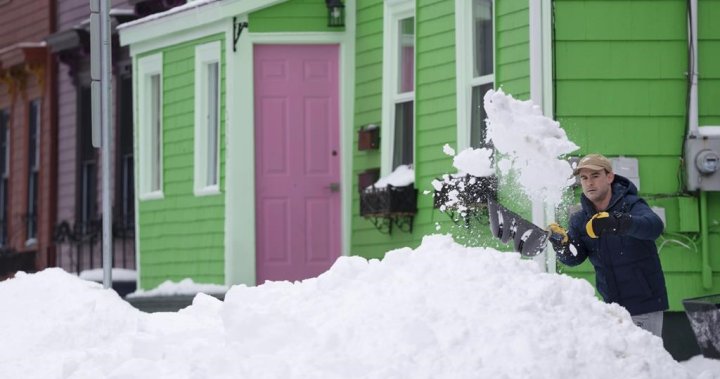Last year’s record-breaking wildfire season forced Canadians to become familiar with the scale of air pollution as hazardous smoke drifted across the country.
Environment Canada’s colour-coded Air Quality Health Index, designed to help people understand health risks associated with contaminated air, was closely watched under hazy, orange skies that stretched beyond the Canada-U.S. border.
But the AQHI, measured on a scale from one to 10+, was not calculated the same way in all provinces and some people were unsure how index values applied to their daily activities.
Environment Canada hopes several changes being made this year will improve how air quality-related health risks are communicated and understood by the public.
One of those changes is to the department’s go-to website for weather conditions and warnings across the country: weather.gc.ca. Users can now toggle between different layers of active alerts and display only those related to air quality if that’s their main concern. Detailed air quality warnings are also listed under a separate tab.
When the AQHI exceeds 10 due to wildfire smoke — indicating a “very high” health risk — affected areas appear red on the map.
A new type of air quality advisory will also be issued to warn of potentially worsening health effects and urge people to seriously consider cancelling outdoor events, said Celine Audette, manager of health and air quality forecast services at Environment and Climate Change Canada.
This change was prompted by a “record number” of AQHI 10+ scores during last year’s wildfire season, she said in a phone interview.
That level “exceeds any kind of air quality objective across the world,” Audette said. “It was the worst air quality in Canada, worse than India.”
She said the aim of the stronger advisory language on especially smoky days is to better inform people and help prevent health issues.
That’s also the goal of another, more complex, change that occurred last week.
Audette said Ontario and Alberta have now joined most other provinces in using the federal government’s enhanced version of the AQHI, which measures the levels of fine particulate matter known as PM 2.5 in the air on an hourly basis.
The email you need for the day’s
top news stories from Canada and around the world.
PM 2.5 comes from a wide range of sources, including power plants and vehicles, and it’s a particularly harmful component of wildfire smoke that can travel deep into a person’s lungs and cause or exacerbate health complications.
For years, the “classic” version of the AQHI measured a three-hour rolling average of common air pollutants: ground-level ozone, nitrogen dioxide and PM 2.5.
But British Columbia changed this after realizing the index did not reflect PM 2.5 spikes caused by wildfires and would display low scores even as plumes of smoked rolled in.
Environment Canada has adopted the B.C. model and now runs two parallel calculations: the rolling average of the three air pollutants and the hourly PM 2.5 levels. The AQHI score the public sees is based on whichever measure is higher.
“I think people will see a big difference,” Audette said of the switch.
“In the period of wildfire smoke, if the plume is increasing in your area, you’ll see a difference (in AQHI levels) every hour.”
She said that means a summer program or daycare provider, for example, can quickly adjust kids’ outdoor schedules, and people with asthma can more accurately assess their risks throughout the day if they plan to be outside.
People who want to closely monitor the AQHI in their area can also download the WeatherCAN app and set up custom notifications, she added.
Quebec will continue to rely on its own Info-Smog air quality forecast and warning program, which works well for the province, Audette said.
She said the general health advice during wildfire season remains the same. Everyone should pay attention to air quality advisories in their region and take precautions when AQHI values start to climb.
A rating of 1-3 is low risk, 4-6 is moderate risk, 7-10 is high risk and over 10 is very high risk.
But at-risk groups – including people with respiratory or heart conditions, those who are pregnant, children and the elderly – may feel the effects of smoke and air pollution at moderate levels. When that happens, they should stay indoors as much as possible until the smoke dissipates and wear a well-fitted N95 face mask if they must venture outside, Audette said.
“About 60 per cent of the population is considered at-risk,” she said but noted that air quality advisories are meant to inform, not “scare people.”
“We don’t want people to be stressed. They need to also take care of their mental health.”
One expert at the B.C. Centre for Disease Control said it’s important to put Canada’s air pollution spikes into perspective because the stress and anxiety induced by smoky skies can be more harmful to human health than the smoke itself.
“For the most part, we have excellent air quality in Canada,” Sarah Henderson, the scientific director of environmental health services, said in a phone interview.
“There are folks in the world who live in conditions like we experienced last year, day in and day out throughout their lives because they live in highly polluted cities. And, you know, they still can live long, happy, healthy lives.”
Henderson said air pollution is one of “many, many risk factors” that affect our health and while it’s important to reduce our exposure to wildfire smoke, we shouldn’t panic and eliminate “all of the other good things in our lives because it’s smoky outside.”
“I never want anyone to panic about wildfire smoke. I want them to take it seriously,” she said. “I want them to look at ways that they can reduce exposure in their lives.”
Henderson said staying inside all summer is not the answer for most people. Healthy adults can take simple measures such as masking up on smoky days, she said. If air quality is not ideal, children can still participate in non-strenuous outdoor activities as long as they’re being monitored, she added.
Since wildfire smoke can easily penetrate indoor spaces, people who have chronic respiratory conditions or are pregnant should have a plan that keeps the air in their homes clean, Henderson said. Portable air cleaners and high-efficiency filters can help.
“I want to get to the point where smoke doesn’t cause people such distress as it does now,” she said.




